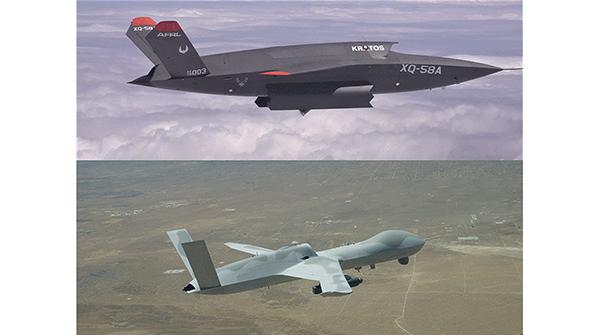
Establishing a program of record to acquire and field the U.S. Air Force’s first unmanned aircraft system capable of making certain tactical decisions by itself now may only be a matter of time.
Skyborg—a suite of autonomous control software capable of being uploaded to a multitude of new and existing unmanned aircraft systems (UAS)—will be ready by fiscal 2023 to take the next step in the acquisition process.
- Skyborg will be ready by 2023, U.S. Air Force says
- ODIN software suite continues experiments
“The team has always been committed to transitioning Skyborg to a program of record, and we’ll be ready in 2023 as the Air Force prepares its [fiscal 2023] President’s Budget submission early next year,” Brig. Gen. Dale White, program executive officer for fighters and advanced aircraft, said in a statement released on Aug. 16.
The first day on the Pentagon’s fiscal 2023 calendar is nearly 13 months away, but the budget process demands that such decisions must be made soon. The Defense Department usually approves the classified Program Objective Memorandum for a given fiscal year in the preceding fall, which is translated into the Future Years Defense Program, a six-year budget forecast.
To move the pioneering program forward, White’s Program Executive Office and the Air Force Research Laboratory (AFRL) still face technical, tactical, cultural and fiscal hurdles. Nonetheless, the Skyborg program promises a revolutionary leap in UAS capability.
The Air Force’s existing fleet of autonomous aircraft is either remotely piloted or uses an onboard autopilot to follow navigational waypoints set by a human controller.
But even the most sophisticated military UAS, such as the Northrop Grumman RQ-4 or the General Atomics Aeronautical Systems Inc. (GA-ASI) MQ-9, still relies on a human to observe the tactical environment and make decisions as necessary. A sensor onboard an MQ-9 may detect a pop-up surface-to-air missile launcher, for example, but the system depends on a human pilot to decide whether to engage or steer away from the threat.
Aided by a software suite enabled with artificial intelligence, the future family of Skyborg UAS will have the ability to observe the tactical situation, recognize threats and—in some cases—decide how to respond without human intervention. Depending on the rules of engagement, that process may still require the UAS to report back to a human operator to make a final decision. And if communications are denied, Skyborg will be programmed to choose from among a menu of options that comply with the commander’s mission objectives.
Another intended feature of the Skyborg software is transferability. Any manned or unmanned aircraft now flies with a suite of highly customized software. With that in mind, the goal of Skyborg is to create a government-owned suite of software code that could be simply uploaded into the mission computer of any UAS. The AFRL’s software suite is named ODIN, an acronym the Air Force declines to define. Meanwhile, the Navy is using a different software suite for UAS autonomy called Research and Autonomy Innovation Development Environment and Repository, or Raider, which is derived from DARPA’s Collaborative Operations in Denied Environment program.
But that level of autonomous operation in a nonexperimental environment may still be years away. So far, the Air Force’s Autonomous Attritable Aircraft Experimentation series, which was launched to support Skyborg, has been limited to the basics. In late April, a Kratos UTAP-22 flew for the first time with the ODIN software aboard. Nearly two months later, a GA-ASI MQ-20 Avenger also flew with ODIN software during the U.S. Air Force’s Orange Flag test exercises. In both flights, a safety pilot established the UAS in level flight at altitude before handing over control to the onboard ODIN software, which proceeded to make basic aeronautical commands. In upcoming experiments, the software will be asked to accomplish formation flights with other UAS.
Advancing Skyborg into a program of record also demands a mission for the UAS to perform. In the near-term future, an early steppingstone to help mature the technology may be inserting the ODIN software into UAS that can perform a subset of the adversary air role on training flights. A future fleet of Skyborg UAS also could be used in combat missions, augmenting manned aircraft.
“The exciting thing about Skyborg is you have the autonomous piece, you have the affordable vehicle piece and then you have the mission system piece,” White said. “So, I think we’re on the right path. We’re testing all three of those aspects out over time. The next 12 months [for Skyborg experimentation] are going to be phenomenal, and we’re pretty excited about where we’re going.”





